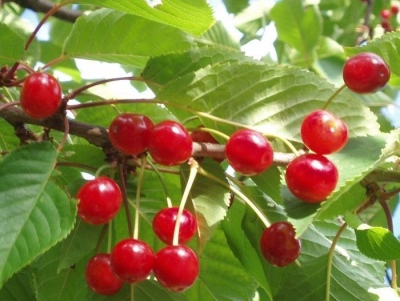
- Authors: folk selection
- Barrel type: wood
- Crown: spherical
- Foliage: abundant
- Leaves: emerald green
- Fruit size: average
- Fruit shape: rounded, slightly flattened
- Fruit color: bright pink
- Fruit weight, g: 2-3
- Pulp (consistency): watery
Variety Flask pink is a tall tree on which beautiful translucent pink berries appear in the middle of summer. The culture does not have good frost resistance, but it is undemanding to the composition of the soil. The fruits are usually eaten fresh, but sometimes they are used for canning, making desserts.
Breeding history
A variety of Russian folk selection, widespread in the Volga region. Described and included in the State Register in 1947.
Description of the variety
The tree is tall, reaching a height of 3-4 m. The crown is spherical, very leafy, becomes spreading with age. Shoots slightly curved, thin and flexible, brown, with a slight silvery bloom. Leaves are oval-elongated, medium-sized, emerald green. Flowers are 2.5 cm in size, there are usually 4 of them in inflorescences. Flowering begins in May. Fruits appear on bouquet branches. The variety is often used as a pollinator for self-fertile species.
Fruit characteristics
Drupes are medium in size, weight is 2-3 g. Rounded, slightly flattened, bright pink. The pulp is soft, watery, pink-yellow, the skin is thin, dense, translucent. The stone is small, well detachable. Low transportability.
Taste qualities
The taste is delicate, sweet and sour, refreshing. Sugar content - 10.2%, fruit acids - 1.3%, ascorbic acid - 16.3 mg per 100 g.
Ripening and fruiting
The pink bottle begins to bear fruit 4 years after planting. The harvest ripens in the first half of July. Overripe drupes instantly crumble. Ripeness is determined by light: a bone should be visible through a thin skin.

Yield
7-8 kg are removed from the cherries. The amount of the crop largely depends on the region: in the Leningrad region, about 5 kg are removed from a 10-year-old tree, and in the Saratov region - up to 15-18 kg.
Growing regions
The species is recommended for landing in the North-West, Middle Volga, Lower Volga regions. However, in practice, the variety is grown everywhere.
Self-fertility and the need for pollinators
The plant is self-fruitless, pollinators are required to obtain a crop: Vole, Vladimirskaya, Pink bottle.
Landing
The optimal planting time is April. For seedlings, choose a well-lit place, protected from the wind, near a wall or a blank fence, preferably on a hill. The soil should be prepared in advance. Sour is usually lime: 400 g of lime per 1 sq. m, organic additives are introduced into the poor one (15 kg of manure or compost per 1 sq. m). Sand is added to the clay. There should be a gap of 2-3 weeks between liming and organic application. Liming is carried out first.
There should be a distance of 6 meters between the seedlings, between the rows - 4-5 m. The size of the planting pit is as follows: diameter - 80 cm, depth - 60 cm. Plants are planted in the same way as other cherry trees.


Growing and care
The plant needs moderate watering. To increase yields, trees must be watered during the formation of buds, during the pouring of fruits and after they are removed. In October, water-charging watering is carried out so that the plant is better prepared for winter. After very cold winters, crop yields may decline.
The crown is formed according to a sparse-tiered system. Weak and stunted shoots are regularly removed. Frozen branches are removed in the spring during the awakening of the buds.


Disease and pest resistance
The variety has an average immunity to a number of diseases and pests. It is moderately resistant to coccomycosis. It is weakly affected by the mucous sawfly. Pests can be attacked by cherry elephant, shoot moth, cherry fly and aphid. From pests and to prevent fungal diseases in early spring and late autumn, trees are treated with a solution of copper sulfate. To protect the crop from birds, they are covered with special nets.
Requirements for soil and climatic conditions
The culture is distinguished by an average degree of winter hardiness. It can withstand frosts down to -23 degrees, in very cold winters wood and flower buds freeze. In regions with frosty winters, it is recommended to cover the trunk and branches with dense material, and mulch the root area with a layer of 15 cm.The variety tolerates different weather conditions well, is undemanding to the composition of the soil. The best soil is loamy, rich in nutrients, air and moisture permeable.

Review overview
According to gardeners, the pink bottle is a capricious variety, because it is very difficult to determine the harvest time. The harvest, when ripe, immediately begins to crumble. The fruit makes a very beautiful transparent rose jam.































































